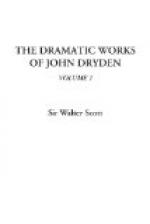Another remarkable feature in the comedies which succeeded the Restoration is the structure of their plot, which was not, like that of the tragedies, formed upon the Parisian model. The English audience had not patience for the regular comedy of their neighbours, depending upon delicate turns of expression, and nicer delineation of character. The Spanish comedy, with its bustle, machinery, disguise, and complicated intrigue, was much more agreeable to their taste. This preference did not arise entirely from what the French term the phlegm of our national character, which cannot be affected but by powerful stimulants. It is indeed certain, that an Englishman expects his eye, as well as his ear, to be diverted by theatrical exhibition; but the thirst of novelty was another and separate reason which affected the style of the revived drama. The number of new plays represented every season was incredible; and the authors were compelled to have recourse to that mode of composition which was most easily executed. Laboured accuracy of expression, and fine traits of character, joined to an arrangement of action, which should be at once pleasing, interesting, and probable, require sedulous study, deep reflection, and long and repeated correction and revision. But these were not to be expected from a playwright, by whom three dramas were to be produced in one season; and in their place were substituted adventures surprises, rencounters, mistakes, disguises, and escapes, all easily accomplished by the intervention of sliding panels, closets, veils, masks, large cloaks, and dark lanthorns. If the dramatist was at a loss for employing these convenient implements, the fifteen hundred plays of Lope de Vega were at hand for his instruction; presenting that rapid succession of events, and those sudden changes in the situation of the personages, which, according to the noble biographer of the Spanish dramatist, are the charms by which he interests us so forcibly in his plots.[7] These Spanish plays had already been resorted to by the authors of the earlier part of the century. But under the auspices of Charles II., who must often have witnessed the originals while abroad, and in some instances by his express command, translations were executed of the best and most lively Spanish comedies.[8]




